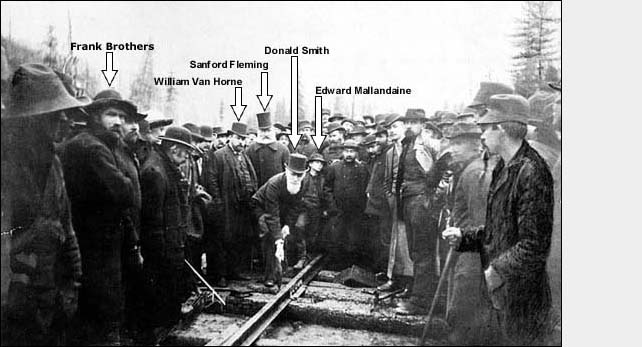
2012
|


Craigellachie - 7 Nov 1885 Alexander J. Ross.
3 July 2012
Victoria Appraiser Helps Nail Down History of Canadian Railway's Silver Icon
An untold story of the Canadian Pacific Railway's Last Spike has been uncovered, thanks to two B.C. historical experts and a tiny error,
handwritten 126 years ago.
The solid silver railway spike, likely fashioned by a Montreal silversmith according to its stamped hallmarks, was donated last month to the Canadian Museum of
Civilization in Gatineau, Quebec.
But it was two accompanying handwritten letters, one written by 1880s-era governor general Lord Lansdowne, and the other penned by hard-driving CPR executive
and later company president William Van Horne, that offered the real clues to the history of this Canadian icon.
Victoria artifact appraiser Bjarne Tokerud and Vancouver colleague Steve Lunsford, hired to examine the silver spike for value and authenticity, ended up
relying on the two letters for the truth about the Last Spike.
"The two letters are really significant because they really establish the history of the Last Spike," Tokerud said in an interview. "That's what
really sealed the deal."
One letter, from Lansdowne to Van Horne, apologizes for not making it to the 7 Nov 1885, ceremony at Craigellachie in eastern B.C. As a token, he presents Van
Horne with the silver railway spike as a souvenir, by then mounted on a granite pedestal.
"You must endeavour and bring yourself to believe that having set my heart on driving in the Last Spike, I brought it with me," Lansdowne wrote in
the letter dated 1 Apr 1886.
The second handwritten letter, from Van Horne to Lansdowne, at first confused the two appraisers.
Why would he have kept an outgoing letter? The real, original letter would be filed away with Lansdowne's own papers.
And why would Van Horne handwrite a draft on letterhead stationery?
But then the two appraisers realized Van Horne's letter to Lansdowne had an error in it. And the two appraisers had one of those research insights they
describe as an "ah-ha, lightbulb" moment.
Van Horne, writing to Lansdowne, the governor general, addressed him throughout as "Your Excellency", except in one case where he left out the word
"Excellency." It was then inserted using a little hand drawn triangular peak.
This, the two appraisers now believe, was the intended letter, that is, until the mistake was discovered. It was most likely written again and sent off. Van
Horne held on to the one with the error, along with the one from Lansdowne himself.
"I find it impossible to explain my gratification and delight at receipt of the silver spike you have been so kind as to send me," wrote Van Horne in
the 3 Apr 1886, letter. "I shall prize it most highly."
Lunsford said it's important to understand the social etiquette of the 19th century when it came to written correspondence.
To receive a gift and a handwritten letter from someone as august as Lord Lansdowne was a huge honour. Answering it required a handwritten personal expression
of thanks.
"Van Horne would have done it by hand to indicate his respect, and he would have wanted it to be perfect, because that's also a sign of respect,"
said Lunsford. "And it was an error in form and protocol, and you just didn't do that.
"And you don't send the governor general a marked up thing: Oh, I couldn't be bothered to do it over again."
The story of the Last Spike is largely unknown to Canadians outside the descendants of Van Horne, who donated it to the Canadian Museum of Civilization. Even
the late Canadian author and historian Pierre Berton, in his book "The Last Spike", published in 1971, mentioned the existence of a silver railway
spike only in passing. Berton gave no indication that it had been preserved.
Tokerud and Lunsford say the story starts with Lansdowne travelling to the Last Spike ceremony on the CPR in 1885, carrying the silver spike in his pocket.
When he reached the end of the line, not yet joined to the one extending from the West Coast, he simply rode a horse over, then travelled by train to Port
Moody, the western terminus of the CPR. Having made it to tidewater, Lansdowne intended to travel back on the CPR.
But since it was late fall, a snowfall blocked the train from carrying him back through the Rocky Mountains to Craigellachie for the Last Spike ceremony.
So Lansdowne made his way back to Ottawa, probably on American railway lines.
In Craigellachie, meanwhile, Donald Smith, the oldest of the CPR directors, hammered in an iron spike. On his first attempt, the spike was bent. The second one
was hammered into the hole and retrieved (it is now at the Canada Science and Technology Museum in Ottawa) and the final spike was driven home, probably by a
railway worker.
Editor's Note: The second iron spike driven by Donald Smith (Lord Strathcona) was retrieved by Roadmaster Frank Brothers following the ceremony.
He was afraid souvenir hunters would tear up his track to obtain the prize. Frank Brothers may be seen in the famous Last Spike photograph above. It was this
second iron spike that was presented to Edward Beatty and subsequently stolen from his desk. At some point it was fashioned into a knife and silver plated. It
now resides in a safety deposit box in Winnipeg. A spike was given to Canada by Donald Smith's great grandson during a ceremony at Craigellachie in 1985, one
hundred years after the driving of the Last Spike on 7 Nov 1885. The question arises: which iron spike did Donald Smith's great grandson present in 1985?
The original bent spike or a second plain iron spike? Which cut up iron spike resides in the Ottawa Science and Technology Museum?
Lunsford, who is familiar with other last spike ceremonies in the western U.S., said in many cases, the last spike would be tapped in, then taken out.
Other last spikes, including a famous gold last spike from California, were souvenirs fashioned afterward.
Calling any of them "the Last Spike," in fact, is a bit of a paradox, because any real last spike would be in the rail line.
But this silver one, fashioned in Montreal and carried by the governor general to B.C., then taken back, mounted on a pedestal of Quebec granite, and presented
to Van Horne, qualifies for the title.
The silver Last Spike was intended to be driven home and retrieved afterward, but it never made it to the ceremony. Instead, the CPR completion ceremony was
improvised, the historians contend.
"This Last Spike was just never driven because it never made it there," said Lunsford.
David Morrison, director of archeology and history at the Canadian Museum of Civilization, said other "Last Spikes" made of iron exist.
Recently, a newspaper story identified an individual who claims to have the spike bent by Smith in his first hammering attempt. It has since been transformed
into a knife.
The Canada Science and Technology Museum has the spike said to be the second one driven in and retrieved by Smith. Part of that spike was said to be shaved off
and made into jewelry for Smith's wife.
Morrison said he likes the silver one better.
"It's complete, it's symbolic, and it's iconic," he said. "We are very happy to have the silver one".
"It went to Van Horne, who was the guy who built the bloody railway in the first place, and it has a nice story, of travelling out west and then coming
back."
Richard Watts.
Much more Last Spike here !


 This web site was assembled on Vancouver Island in British Columbia Canada. This web site was assembled on Vancouver Island in British Columbia Canada.
|


